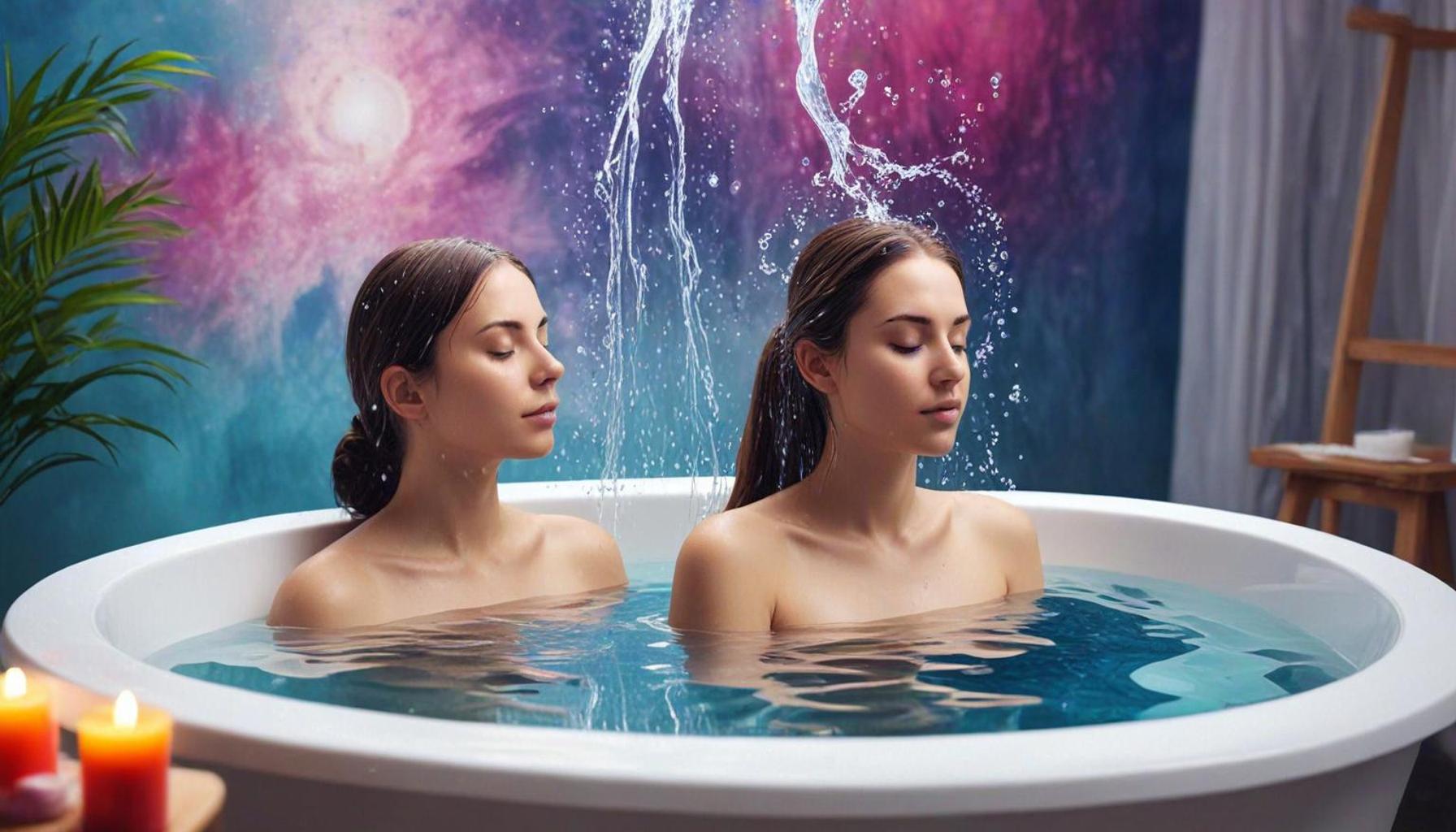The Influence of Water Temperature on Sensory Awareness During Bath Meditation

The Influence of Water Temperature on Sensory Experiences
Water temperature is not merely a physical attribute; it serves as a powerful tool for enhancing sensory experiences during bath meditation. The temperature of the water can evoke a range of sensations that significantly influence our mental and emotional states. By understanding how different water temperatures affect our bodies, we can cultivate deeper connections to our mind and body during meditative practices.
Examining the effects of various water temperatures reveals how they can shape our meditative experience:
- Warm Water: The soothing embrace of warm water is often associated with relaxation. It encourages the release of tension in muscles, which can be especially beneficial after a long day of work or stressful activities. When immersing oneself in warm water, the body responds by dilating blood vessels, promoting better circulation. This process generates feelings of tranquility and comfort, allowing individuals to sink deeper into a meditative state. For instance, a warm bath enriched with essential oils, like lavender, can elevate the experience, leading to not only physical relaxation but also a serene mental landscape.
- Cold Water: In contrast, cold water can provoke a refreshing shock to the system, invigorating the senses and sharpening focus. The sensation of cold water stimulates the body’s natural alertness, often leading to heightened awareness and clarity of thought. For example, many Nigerians engage in early morning cold baths during the harmattan season, harnessing the brisk chill to awaken their senses and prepare for the day ahead. This practice can invigorate the spirit, promoting a more vigorous and alert mindset conducive to meditation.
- Room Temperature Water: Room temperature water provides a balanced and neutral approach to bath meditation. It creates a comfortable environment that is neither too stimulating nor too lax, allowing for a steady and mild meditative state. This temperature can make the experience feel less intimidating for beginners, affording them the space to explore their thoughts without the extremes of warmth or cold. By gradually introducing changes in temperature, one can effectively tailor their bathing experience to their personal needs.
In Nigeria, traditional bath practices often blend with meditation, creating a unique interplay of cultural beliefs and personal mindfulness. For example, in some regions, bathing rituals may include local herbs or flowers, with water temperature playing an essential role in harmonizing the physical and spiritual aspects of the practice. Understanding these nuances allows individuals to deepen their meditation experience, leading to better overall well-being.
As we explore the relationship between water temperature and sensory awareness, it is apparent that these elements can transform ordinary routines into profound moments of self-discovery. Experimenting with different water temperatures can cultivate a more enriching meditation practice, allowing practitioners to uncover their preferences and foster a deeper understanding of their bodies and minds. This journey not only invites curiosity but also encourages readers to engage actively in their self-care rituals.
SEE ALSO: Click here to read another article

The Role of Water Temperature in Enhancing Meditation
Water temperature serves as a crucial factor in shaping our sensory awareness during bath meditation. Each temperature offers a unique set of physical and psychological effects that can either augment or inhibit the meditative experience. By being mindful of the water temperature during meditation, practitioners can optimize their routines for improved focus, relaxation, and clarity. Here are some insights into how varying water temperatures can affect sensory awareness:
- Physiological Responses: The body’s response to temperature is immediate and profound. Warm water naturally increases body temperature, leading to the release of endorphins, which are hormones responsible for feelings of happiness and euphoria. This physiological response can be particularly effective in dissipating stress and combating anxiety. Similarly, cold water prompts a rush of adrenaline and norepinephrine, invigorating blood flow and sharpening cognitive processes. These responses illustrate the strong relationship between water temperature and bodily experience, making it an essential consideration in bath meditation.
- Mental Clarity: Sensory experiences can be enhanced by the way our environment interacts with our physical state. When the body is submerged in warm water, the mind often drifts into a relaxed state, creating a conducive atmosphere for meditation. This relaxed mental state allows for deeper contemplation, making it easier to focus on breath and mindfulness practices. On the contrary, the brisk impact of cold water captures the mind’s attention, fostering mental clarity and focus. This contrast in effects denotes the vital role of temperature in guiding mental states during meditation.
- Cultural Context: The interplay between water temperature and sensory awareness is especially significant in Nigeria, where traditional practices meld with contemporary methods of self-care. For example, in various Nigerian communities, medicinal plants are steeped in warm water, creating herbal baths that soothe both body and spirit. Local beliefs hold that the temperature of the water can enhance the healing properties of these herbs. Moreover, the experiential aspect of cold baths, particularly in a hot climate, can provide refreshing relief and stimulate sensory awareness, influencing both emotional and mental well-being.
Furthermore, the subjective nature of temperature perception should not be overlooked. Each individual may respond differently to warm, cold, or room temperature water. Preferences are likely shaped by factors such as personal background, climate, and individual body rhythms. This variance invites practitioners to experiment with different temperatures during their baths, uncovering what resonates best with their unique sensory awareness. Ultimately, the exploration of water temperature offers an inviting pathway for individuals to deepen their meditative practices and cultivate a more profound connection with their inner selves.
The Role of Water Temperature in Enhancing Experiential Awareness
Water temperature plays a crucial role in bath meditation, significantly affecting sensory awareness. When considering the effects of warm water, the body experiences increased circulation. This physiological response not only promotes relaxation but also enhances overall sensory perception. Warm water helps to ease muscle tension, allowing the mind to focus on the present moment, amplifying the meditative experience.Conversely, cool water can invigorate the senses and promote alertness. This can create an interesting balance between relaxation and heightened sensory awareness. The sudden change in temperature stimulates the body’s nervous system, cascading awareness and sharpening concentration. Different temperatures can evoke various emotional responses, leading to deeper introspection during meditation.Moreover, the psychological implications of water temperature cannot be overlooked. The sensation of warmth can evoke feelings of safety and comfort, which are vital for achieving a meditative state. Meanwhile, cool water may contribute to a sense of cleansing or renewal, inviting a more reflective mindset. By experimenting with water temperatures during bath meditation, practitioners can discover their own preferences, tailoring their experiences to suit their evolving emotional and psychological needs.Expanding upon this understanding, it becomes evident that the influence of water temperature is not merely physical but extends deeply into mental and emotional realms, influencing the overall efficacy of meditative practices. Engaging with this knowledge can motivate individuals to explore varying water temperatures, thereby enriching their meditation experiences and fostering greater sensory awareness.
| Category 1 | Category 2 |
|---|---|
| Warm Water Effects | Increases circulation, promotes relaxation, enhances sensory focus. |
| Cool Water Benefits | Invigorates senses, sharpens concentration, stimulates nervous system. |
Understanding these effects can transform the practice of bath meditation, inviting individuals to embrace the diversity of sensory experiences shaped by water temperatures. As practitioners delve deeper, they may uncover further layers of awareness, enhancing their mindfulness journey.
ADDITIONAL INSIGHTS: Expand your understanding here
Exploring the Psychological Dimensions of Temperature Variability
The psychological impact of water temperature during bath meditation extends beyond mere physical sensations; it intricately intertwines with emotional states and mental frameworks. By analyzing the psychological dimensions of this relationship, we gain a better understanding of enhancing our sensory awareness through deliberate temperature selection.
- Emotional Regulation: The enduring comfort of warm water can evoke feelings of safety and security. This sense of warmth often acts as an emotional blanket, encouraging deeper introspection and the exploration of one’s emotional landscape. In the context of bath meditation, such emotional regulation enables practitioners to confront underlying feelings with enhanced clarity and acceptance. For instance, the soothing properties of warm baths can facilitate a meditative state where negative emotions are processed, fostering resilience and emotional healing. Conversely, cold baths can invigorate and awaken the senses, enabling users to approach their emotions with a fresh perspective, which can be particularly valuable during moments of emotional stagnation.
- Mindfulness and Present Moment Awareness: Temperature, as a sensory element, sharply draws our focus to the present moment. The acute sensations experienced when shifting from cool air to warm or cool water can dramatically heighten awareness. This contrast not only enhances the sensory experience during bathing but also cultivates mindfulness, encouraging practitioners to anchor themselves in the here and now. Research suggests that such sensory engagement can heighten neural activation in regions of the brain associated with attention and consciousness, reinforcing the critical role of temperature in bath meditation.
- Social and Communal Aspects: In many Nigerian cultures, communal bathing practices incorporate various temperatures for both social bonding and spiritual cleansing. Traditional beliefs often associate specific temperature baths with rituals for reconciliation, healing, and emotional catharsis. For instance, a community may come together to share a warm herbal bath infused with local botanicals, where the heat symbolizes unity and collective healing. In contrast, individuals seeking solitude might prefer cold water for its invigorating qualities that promote self-reflection and rejuvenation. This cultural context showcases the collective influence of temperature in guiding emotional and sensory experiences during meditation.
Moreover, the social context of bath meditation in Nigeria influences individual perceptions of water temperature. The communal sharing of warm baths laden with spiritual intentions often invites dialogue about emotional experiences, enriching the meditative practice with community support. This sociocultural layer cultivates a nuanced understanding of how environmental factors can be leveraged to enhance sensory experiences, particularly in a country rich with diverse traditions.
The interplay between water temperature and sensory awareness also invites us to consider seasonal and climatic variations. For instance, the heat prevalent in Nigeria’s dry season makes cold baths particularly appealing for not just physical relief but also for reinvigorating mental energy. Individuals might find that adjusting their bath temperatures according to the season not only affects their physical comfort but also their emotional well-being and capacity for meditation. This adaptability highlights the importance of experimenting with water temperatures to fully harness the benefits of bath meditation.
Overall, the psychological dimensions of water temperature in bath meditation uncover essential insights into emotional regulation, mindfulness, cultural significance, and seasonal adaptability. Practitioners are encouraged to explore these dimensions intentionally, leading them to experience a richer, more connected meditative journey.
LEARN MORE: This related article may interest you
Concluding Reflections on Water Temperature and Bath Meditation
In light of the extensive exploration of water temperature and its profound effects on sensory awareness during bath meditation, we can clearly see how intricately this relationship influences both emotional and psychological well-being. The deliberate selection of warm or cold water not only alters our physical comfort but significantly shapes our mental landscape, allowing practitioners to navigate their emotional journeys with enhanced clarity.
The concept of emotional regulation through varying water temperatures invites individuals to confront their feelings with greater acceptance, while also encouraging a rich state of mindfulness that anchors them in the present. This practice can empower practitioners to explore the depths of their emotions, utilizing warm baths for introspection or cold ones for revitalization. Additionally, the socio-cultural dimensions, particularly within Nigerian contexts, emphasize the communal aspects of bath meditation, showing how collective experiences can deepen emotional connections and spiritual healing.
Ultimately, embracing seasonal and climatic variations reinforces the idea that our bath practices should evolve alongside our environments, presenting an exciting opportunity for personal exploration. Practitioners are encouraged to experiment with water temperatures, creating unique rituals that cultivate a profound understanding of their sensory experiences.
As we conclude, it is clear that the influence of water temperature in bath meditation goes beyond mere physical sensations, igniting a pathway toward holistic well-being and spiritual growth. Those who embark on this immersive journey stand to gain not only from the therapeutic properties of their chosen water but also from the expansive insights it can bring into their daily lives.



